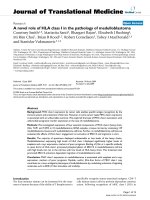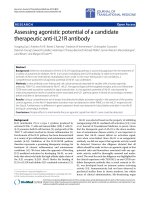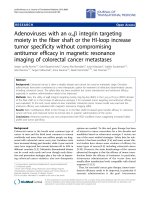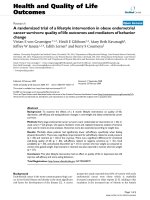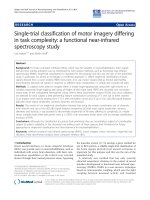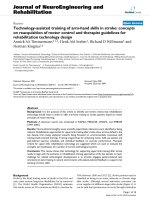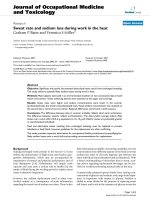báo cáo hóa học:" Assessing mechanical integrity of spinal fusion by in situ endochondral osteoinduction in the murine model" potx
Bạn đang xem bản rút gọn của tài liệu. Xem và tải ngay bản đầy đủ của tài liệu tại đây (1.27 MB, 9 trang )
RESEA R C H ART I C L E Open Access
Assessing mechanical integrity of spinal fusion by
in situ endochondral osteoinduction in the
murine model
Ashvin K Dewan
1*
, Rahul A Dewan
1
, Nathan Calderon
1
, Angie Fuentes
1
, ZaWaunyka Lazard
2
, Alan R Davis
2
,
Michael Heggeness
1
, John A Hipp
1
, Elizabeth A Olmsted-Davis
2
Abstract
Background: Historically, radiographs, micro-computed tomography (micro-CT) exams, palpation and histology
have been used to assess fusions in a mouse spine. The objective of this study was to develop a faster, cheaper,
reproducible test to directly quantify the mechanical integrity of spinal fusions in mice.
Methods: Fusions were induced in ten mice spine using a previously described technique of in situ endochondr al
ossification, harvested with soft tissue, and cast in radiolucent alginate material for handling. Using a validated
software package and a customized mechanical apparatus that flexed and extended the spinal column, the
amount of intervertebral motion between adjacent vertebral discs was determined with static flexed and extended
lateral spine radiographs. Micro-CT images of the same were also blindly reviewed for fusion.
Results: Mean intervertebral motion between control, non-fused, spinal vertebral discs was 6.1 ± 0.2° during spine
flexion/extension. In fusion samples, adjacent vertebrae with less than 3.5° intervertebral motion had fusions
documented by micro-CT inspection.
Conclusions: Measuring the amount of intervertebral rotation between vertebrae during spine flexion/extension is
a relatively simple, cheap (<$100), clinically relevant, and fast test for assessing the mechanical success of spinal
fusion in mice that compared favorably to the standard, micro-CT.
Background
Spinal fusion is a common surgical procedure used to
manage a variety of disorders. In 2001, over 50% of all
inpatient lumbar spine operations, other than those for
herniated discs, included a fusion procedure [1]. In
2001, $4.8 billion was spent on spine fusion surgery [1].
In 1992, lumbar fusion accounted for 14% of spending,
but by 2003, fusion accounted for almost half of total
spending on spine surgery [2].
Currently, the gold standard for sp inal fusion involves
a bone autograft from the pelvis [3]. This technique has
several limitations. Donor site complications and mor-
bidity have been estimated at 8% to 25% [4-7]. Donor
site complications include pain, nerve and arterial injury,
peritoneal perforation, sacroiliac joint instability, and
herni ation of abdominal contents through defects in the
ilium [8]. Furthermore, the volume of bone extracted
from the donor is often insufficient [7,9] and pseudoar-
throsis is a common result [10]. Given these shortcom-
ings, recent research has focused on finding effective
bone graft substitutes, such as bone mor phogenic
protein (BMP) based osteoinduction.
The feasibility of new technologies is commonly tested
in small animal models first. The number of postero lat-
eral fusion studies involving BMP osteodinduction in
rodents has exploded in the last decade [11-26].
Research to assess the effectiveness of these new tech-
nologies for promoting fusion is compromised however
by the lack of a rapid, economical, validated test to
determine if the treatment was successful. The recent
validation of the rodent as a me chanical model of the
human vertebral disc opens the door to new mechanical
tests of the rodent spine that can be used to test
* Correspondence:
1
Spine Research Lab, Baylor College of Medicine, Houston, TX USA
Full list of author information is available at the end of the article
Dewan et al. Journal of Orthopaedic Surgery and Research 2010, 5:58
/>© 2010 Dewan et al; licens ee BioMed Central Ltd. This is an Open Access article distributed under the terms of the Creative Commons
Attribution License ( which permits unrestricted use, distribution, and reproduction in
any medium, provide d the origin al work is properly cited.
efficacy, in addition to feasibility, of emerging spinal
fusion strategies [27].
Historically, radiographs, micro-computed tomography
(micro-CT) exams, palpation and histology have been
used to assess fusions in a mouse spine. High-resolution
micro-CT can reliably determine if a mechanical bridge
hasformed,butthisisexpensive,timeconsuming,and
only reli able if the exam is very carefull y assessed, since
a fusion mass can get very close to a bone but remain
separated by a thin layer of soft-tissue (Figure 1). The
objective of this study is to develop a rapid and re pro-
ducible test to directly quantify the mechanical integ rity
of spinal fusions in mice. A validated test for fusion effi-
cacy in the mouse spine would be used in many future
studies of new biologic fusion technologies.
Materials and methods
Cell Culture
Human diploid fetal lung fibroblasts (MRC-5) obtained
from American Type Culture Collection (ATCC; Mana-
ssas, VA) were transduced with adenovirus encoding
BMP-2 as described by Fouletier-Dilling, et al [28].
A control set was also prepared using the same cell l ine
transduced with adenovirus without BMP-2 encoded.
For implantation, the control and experimental cells
were isolated from the growth medium and re-sus-
pended at 5.6 × 10
6
cells/ml in saline medium.
Implantation
Male and female NOD/SCID mice (8-12 weeks old;
Charles River Laoratories; Wilmington, MA) were
placed separately at five per cage and fed with an ad
libitum diet and tap water in a 12 h day/night cycle
according to our Institutional Animal Care and Use
Committee (IACUC) protocols until ready for surgery.
Experimental protocol was approved by our IACUC.
Thebacksofthemicewereshavedandcleansedwith
alcohol. The senior spinal surgeon listed injected 500ul
of the appropriat e cell suspension prepared as describe d
above unilaterally adjacent to the spinous process of the
L4-L5 vertebrae in mice in the body of the parasp inous
muscles in a 1 cm track within the muscle body. Sutures
were placed superior and inferior to mark the injection
sit e. The animals were then returned to their respective
cage for the remainder of the study.
A total of twenty animals were used for this experi-
ment. Ten mice, 5 female and 5 male, received injec-
tions of the experimental cell suspension that produced
encoded BMP protein. Ten mice, 5 female and 5 male,
received an injection of the control culture that did not
encode BMP protein. The mice were euthanized at
6 weeks.
Mechanical Testing
Following euthanasia, spines were harvested from the
first lumbar to the first sacral vertebrae with all sur-
rounding musculature and pelvis intact. The harvested
spines were fixed and stored in formaldehyde until
ready for testing. Of note, it is unclear what effect, if
any, fixation has on the mechanical attribu tes of the tis-
sue. For mechanical testing spines were first cast in the
center of a 2 × 1 × 4 cm block of dental Alginate
impression material (Henry Schein, INC., Melville, NY).
Next, spines were imaged on high resolution Xray in
flexion, neutral , and extension using the custom crafted
flexion and extension cells described below. The images
were then analyzed using computer-assisted methods on
Quantitative Motion Analysis (Medical Metrics, Hous-
ton,TX)thathasbeenpreviously validated [29] and
use d to assess the mechanical integrity of spinal fusions
in human patients. The computer-assisted analysis
quantified the amount of intervertebral motion within
±0.1 that o ccurred in flexion and exten sion. Following
the mechanical testing, the spine was imaged at
14 micron resolution using the micro-CT system. From
the micro-CT data, three dimensional reconstructions of
the vertebrae and any mineralized tissue were made
(eXplore MicroView, v. 2.0, GE Healthcare, London,
Ontario). A surgeon blindly reviewed the mouse spine
CTs for fusions. Accuracy of spine fusion identification
Figure 1 Spine micro-ct image examples with heterotopic bone formation.
Dewan et al. Journal of Orthopaedic Surgery and Research 2010, 5:58
/>Page 2 of 9
by CT was compared to the mechanical testing of the
same spines.
Testing Apparatus
Three devices were constructed out of radiolucent poly-
ethylene for flexing and extending the mice spines sus-
pended in alginate at 60°, 110°, or 150° (see figure 2).
Three 2 × 10 × 20 cm pieces were cut from polyethy-
lene. Using a hack saw and electric sander arcs of 60°,
110°, or 150°, that is arcs with radius of curvature of
10.0, 6.1, and 5.2 cm respectively were cut into the
pieces. The arc cuts were made perpendicular to the
10×20cmfaces,10cmfromthetopofthelong
dimension at the edge. A 10 × 23 cm frame to support
the plastic pieces was constructed using 2 × 2 cm alumi-
num L brackets, with the L facing inwards along the
longer dimension. Corners of the frame were fastened
using separate 1 × 2 × 2 cm L brackets and bolts with
nuts. The plastics pieces with the arcs cut into it were
next secured to the frame using zip ties. Two 3 cm
screws were placed through the frame and polyethylene
2 cm from the bottom edge of the frame to prevent the
plastic from sliding out. Two springs 3.75 cm uncom-
pressed length with spring constant of 4.2 N/m were
centered on the heads of the two screws supporting the
corner L brackets such that an axial force was directed
parallel to the long dimension of the plastic pieces.
Palpation
Integrity of the fusions was qualit atively confirmed after
removal of soft tissues with bleach and manual palpa-
tion. Sample spines were immersed in 90 cc bleach.
Aft er 45 minutes, 6lb fishin g line was threaded through
the spinal canal of the sample. Samples were then
placed into a tray and covered before submerging in
bleach again for 2 more hours. Bleach was replaced
hourly. Samples with soft tissue remaining on the bones
were submerged and monitored for additional 10 min-
ute intervals until bone was completely cleaned. Bones
were then photographed using a high resolution camera.
Linking of adjacent vertebrae by fusion was documented
when present.
Statistics
Student’ s t-test was used to compare means of fused
and unfused groups. Sensitivity and specificity calcula-
tions were performed using Stata Ver 10 (Stata Corp,
College Station, Texas).
Results
All mice tolerated surgery without any complications.
Biomechanical characterization of untreated control
spines was performed first to determine optimal spinal
flexion/extension conditions for testing fusion integrity.
Maximal intervertebral motion of untreated spines was
obs erved at 150°of spinal flexion/extension. Interverteb-
ral disc angle change of untreated mice followed normal
distributions centered at means of 3.9 ± 0.4°, 5.0 ± 0.2°,
and 6.1 ± 0.2° per level for 60°, 110°, and 150° of spinal
flexion/extension respectively (Figure 3). The greatest
variability in intervertebral motion was observed
between the proximal lumbar discs of the harve sted
spine. In addition, mean intervertebral motion between
distal lumbar vertebrae levels was slightly greater than
Figure 2 Custom designed apparatus for flexing/extending explanted spine.
Dewan et al. Journal of Orthopaedic Surgery and Research 2010, 5:58
/>Page 3 of 9
Figure 3 Histogram of Mean Intervertebral Disc Angle Change in Untreated Mouse Spine during 60°, 110° and 150° of Spinal Flexion/
Extension.
Dewan et al. Journal of Orthopaedic Surgery and Research 2010, 5:58
/>Page 4 of 9
mean intervertebral motion at proximal lumbar verteb-
rae levels (Figure 4), but not significant. Given the small
magnitude of i ntervertebral motion observed at 60° flex-
ion/extension of the untreated spines, subsequent fusion
sample testing was conducted successively at only 110°
and then 150° for maximal int ervertebral disc angle
change detection.
Injections of cells producing BMP-2 in the posterior
paraspinal muscles resulted in situ endochondral ossifi-
cat ion adjacent to vertebrae. Mineralized tissue of vary-
ing degrees was pres ent by radiographic examination in
all treatment animals at 6 weeks postoperatively. Distin-
guishing between bridged transverse processes and
unbridged mineralized tissue was difficult with anterior-
posterior and lateral radiographs. Untreated control ani-
mals did not demonstrate any osteoinduction by radio-
graphic examination.
Microcomputed Tomography inspection of explanted
spines exposed to BMP-2 was performed taking an aver-
age 5 hours/spine (including preparation, scanning, and
examinat ion). After 6 weeks of treatment, posterolateral
osteoinduction bridging transverse processes of adjacent
lumbar vertebral levels were observed in 9/10 treated
spines. Fusion occurred at greater than two adjacent
vertebrae for 5 of these spines. One such spine had 5
successive lumbar vertebrae, L1-L5, fused. The only
spine that did not produce any fusion by micro-CT had
a small amount of bone formation localized in the para-
spinal muscle.
Biomechanical characterization of treated spines wa s
performed at 110° and then 150° spinal flexion/exten-
sion. The intervertebral motion between lumbar discs
neighboring the mineralized tissue masses decreased. A
compensatory increase in intervertebral motion between
lumbar discs away from the mineralized tissue was
observed at both 110° and 150° testing. Two separate
peaks of intervertebral disc angle change representing
the linked and unlinked vertebrae from the pool of all
the treated vertebrae were observed at both testing
conditions (Figure 5 ). Mechanical data of fusions were
correlated with CT findings next. Restriction of interver-
tebral motion by min eralized tissue neighbor ing the
spine was variable. However, it was noted, with the
exception of two unfused adjacent vertebrae, all other
adjacent vertebrae that lacked fusion by CT inspection
exhibited greater than 3.5 degrees of intervertebral
motion with the 150 degree flexion/extension testing
condition.
Soft tissue envelopes of explanted spines were success-
fully dissolved using bleach. Segments of fused vertebrae
in treated spines were palpated to co nfirm mechanical
integrity. After 6 weeks ofexposuretoBMP-2,all10
spines grossly exhibited linked vertebrae. Furthermore, 8
of these spines had greater tha n 2 adjac ent linked ver-
tebrae, with one spine exhibiting fusion from L1-L5
after bleach dissolution.
Levels coded as fused by palpation after BMP- 2 expo-
sure showed significantly decreased (p < 0.05) interver-
tebral motion at 110° and 150° testing (2.4 ± 0.3° and
4.2 ± 0.4° respectively) compared to controls (Figure 6).
Levels coded as fused by micro-CT after BMP-2 expo-
sure also showed a significant decrease in intervertebral
motion at 110° and 150° testing (3.1 ± 0. 3° and 3.5 ±
0.4° respectively) compared to controls. Fusions
Figure 4 Mean Intervertebral Disc Angle Change in Untreated Mice Spine at each Vertebral Level during 150 of Spinal Flexion/
Extension.
Dewan et al. Journal of Orthopaedic Surgery and Research 2010, 5:58
/>Page 5 of 9
identified by micro-CT however were relatively more
stable compared to t he fusions found by palpation. The
lower rate of false positive fusions by the micro-CT rela-
tive to the palpation group might explain the decreased
intervertebral motion observed. For both methods of
identification, the percentage of intervertebral motion
decrease from f usion was greater at 110° testing com-
pared to 150° testing.
Finally, the sensitivity and specificity of mechanical
testing of fusion was calculated. The challenge in per-
forming t hese statistics was the lack of a definitive gold
standard. Our perception is that a very careful assess-
ment of micro-CT exams is the best method, but none
of the assessments made can be assumed to be correct
100% of the time. Using micro-CT assessment as the
gold standard, 84% of the levels analyzed were correctly
classified using our mechanical test. The sensitivity and
specificity for identifying a fusion that limited interver-
tebral motion to ≤3.5° under the 150° mechanical testing
condition was 54% and 94% respectively. Compared to
micro-CT, there were f alse-negative assessments by
mechanical testing. Or stated another way, fusion
masses qualitatively identified on Micro-CT as bridging
or fusing adjacent vertebrae, did not necessarily restrict
the intervertebral motion.
Discussion
This is the first study to characterize the rodent spine in
flexion-extension testing. Incorporating the same metho-
dologyusedinhumanspinetesting,wewereableto
assess spinal fusion in the rodent model. In humans,
quality of spinal fusions is typically assessed through
Figure 5 Histograms of Mean Intervertebral Di sc Angle Change During 110° and 150° of Spinal Flexion/Extension After Six Weeks
Exposure to Bone Morphogenic Protein-2.
Dewan et al. Journal of Orthopaedic Surgery and Research 2010, 5:58
/>Page 6 of 9
dynamic and static imaging studies [10,29]. After pe r-
forming spinal fusion, surgeons take radiographs of a
patient’s spine in flexion and extension. Based on the
limitations in motion observed between two vertebrae
after fusion, a surgeon can assess the quality of the
fusion. Lately, software has become available that quan-
tifies the degree of intervertebral motion between ver-
tebral discs [29]. Using the same software and a simple,
custom-designed, apparatus (Figure 2) to flex and
extend the explanted rodent spines for radiographs, we
were able to reliably measure interverteral motion in the
rodent lumbar spine.
Currently the most common metho ds for fusion
assessment in the rodent model include histology, palpa-
tion, micro-computed tomography, and radiography. All
of these techniques are qualitative with noteworthy lim-
itations. Histology is accurate at evaluating bone forma-
tion and quality, but it is easy to miss bridging bone in
out of plane sections when looking for fusions [16,25].
Moreover static images of individual sections do not
reveal how the newly mineralized tissue functions dur-
ing physiologic motion of the spine. Palpation of inter-
locked segments is used to classify motion segmen ts as
fused or not fused. Although relative determinations of
fusion strength can be made, this admittedly subjective
technique [26] suffers from significant interobserver var-
iation and unclear relevance to the clinical setting.
Nonetheless, there are some authors that believe palpa-
tion is the most sensitive and specific method of asses-
sing spinal fusion [18,25,30]. Most consider micro-CT
to be the gold standard for fusion determination [16].
On micro-CT bony bridging between adjacent trans-
verse processes is considered fusion. CT is time con-
suming (5 hours/sample in this study) and expensive.
Moreover, determining the significance in the variability
of fusions observed can be challenging. Consequently,
some conside r the combination of micro-CT and palpa -
tion to be optimal [16]. The success rates of fusion
induced by BMP-2 determined by micro-CT and/or pal-
pation reported in literature are 95-100%
[11,12,14,17-19,21,22,24], consistent with our micro-CT
and palpation findings. Finally some studies use radio-
graphic evidence of bony tissue along the margin of the
spine to assess fusion. This is perhaps the most mislead-
ing however since adjacent and integrated mineralized
tissue cannot be readily distinguished leading to overes-
timation of fusion [16]. There is no consensus about
which technique is best for assessing fusion.
Given limitations of current techniques for spinal
fusion assessment, we developed a quantitative biome-
chanical test of interverte bral motion in the rodent
spine. Untreated lumbar mice spines behaved very simi-
lar to untreated human and rabbit l umbar s pine
described in literature [29,30]. Mean intevertebral
motion at L3-L5 of 5.7° reported during flexion and
extension of the human spine is very similar to the
mean intervertebral motion of 6.1° demonstrated in flex-
ion and extension of the mouse spine here [29]. Consis-
tent with trends demonstrated in human and rabbit
lumbar vertebrae, higher rodent lumbar levels also
Figure 6 Comparison of Mean Intervertebral Disc Angle C hange during Spinal Flexion/Extension of Bone Morphogenic Protein-2
Induced Spinal Fusions Identified by Palpation and Micro-CT Techniques.
Dewan et al. Journal of Orthopaedic Surgery and Research 2010, 5:58
/>Page 7 of 9
showed slightly less intervertebral motion compared to
the lower lumber levels [31].
Defining normal intervertebral motion enabled us to
objectively assess the fused r odent spines. The cut-off
that correlated with fusion by micro CT we used,
3.5 degrees, was within the 2°-4° range of cut-offs
reported for fusion in other models [32,33]. Characteri-
zation of fusion products revealed a great deal of varia-
bility in the quality of fusions, not detected by the
existing fusion detection techniques. The induction of
bone at a heterotopic site in the mouse did not necessa-
rily imply t he induction of directed formation of bone
essential for spinal arthrodesis [10]. Often heterotopic
bone bridging transverse processes of the vertebrae was
not capable of restricting intervertebral motion during
spinal flexion/extension. In our testing, 6/16 vertebral
fusions identified by micro-CT were not able to restrict
intervertebral motion less than 3.5 degrees. These 6
“false” negatives result in a lower sensitivity of mechani-
cal testing when compared to micro-CT, the defacto
standard. However, using the quantitative mechanical
technique to a ssess fusions permited the identification
of these pseudoarthroses, and provided additional objec-
tive information about the quality of the fusions
generated.
Grauer et al similarly i dentified differences in fusion
quality not detected by palpationinflexion-extension
testing of a rabbit model [30]. In their experiment, with
the absence of a carrier for injected induction proteins,
the location of bony fusion masses induced was not pre-
cise. The variability in fused domains could explain the
variability in intervertebral motion observed. With pal-
pation alone, the signi ficance of fusion domains was
harder to appreciate. In cadavers, Bono et al demon-
strated the same concept, noting intertranverse process
bridging reduced inervertebral motion less than interspi-
nous processes bridging [32].
A few authors have attempted to devise other quanti-
tative biomechanical tests for assessing the integrity of
spinal fusions in small animal models. Most of these
published tests however require sophisticated equip-
ment. In rabbits, uniaxial tensile mechanical testing of
fusions has been performed [34]. The smaller scale of
rodent model fusions however makes this technique
prohibitive and tedious. Grauer et al developed a flex-
ibility test for intervertebral motion in the rabbit [31].
Another group has compared displacement of fused rat
spine in the sagittal plane with the application of a 3N
force [13]. Generalizing the observations of these ex
vivo tests to the clinical setting however can be trickier
given that the same approaches are not used in the
human.
Finally, the cost of test described here is another
advantage. A dedicated microcomputed t omorgraphy
machines with enough resolution to accurately image
mice spines is usually not readily available. At our insti-
tution, multiple lab s share this resource. A single
machine can cost upwards of $100,000 and r equires
routine costly maintenance. In contrast, the test shown
here can be performed on a rudimentary high resolution
Xray machine that many institutions already have.
Laboratory x-ray systems can cost between $5,000 to
$50,000 depending on the system and whether it is pur-
chased new or used. The software that was used in this
study is not yet available for purchase in a stand-alone
laboratory setting. Other computer-assisted method s
have been described that would likely have similar accu-
racy for this purpose [35,36]. Some spine centers may
alreadyhavesuchsoftwarefortheanalysisofhuman
spinal motion. The cost of constructing the actual test-
ing apparatus was less than $100.
Conclusion
Measuring the am ount of intervertebral rotatio n
between vertebrae that occurs during flexion and exten-
sion is a relatively simple, cheap (<$100), clinically rele-
vant and fast test for assessing the mechanical success
of spinal fusion in mice. E xisting methods of spinal
fusion assessment such as micro- computed tomography
(micro-CT) are time-consuming and cost prohibitive.
Quantitative analysis of intervertebral rotation between
flexion and extension can be used to reliably determine
if adjacent vertebrae are fuse d, with f used levels h aving
less than 3.5 degrees of intervertebral rotation during
150 degrees of spinal flexion/extension. The recent vali-
dation of the rodent as a mechanical model of the
human vertebral disc opens the door to new mechanical
tests of the rodent spine that can be used to test effi-
cacy, in addition to feasibility, of emerging spinal fusion
strategies [27]. With the explosion in the number of stu-
dies using the rodent model for posterolateral spinal
arthrodesis in the last few years [11-26], the develop-
ment of a rapid, reproducible, biomechanical test for
fusion asses sment in rodents, such as the one described
here, is essential.
Abbreviations
BMP: Bone Morphogenic Protein; Micro-CT: Micro-Computed Tomography.
Acknowledgements
Supported in part by an Alpha Omega Alpha Carolyn L. Kuckein Student
Research Fellowship, DOD W81XWH-07-1-0281, and DARPA W911NF-09-1-
0040.
Author details
1
Spine Research Lab, Baylor College of Medicine, Houston, TX USA.
2
Center
for Gene Therapy, Baylor College of Medicine, Houston, TX USA.
Authors’ contributions
AKD drafted manuscript, constructed mechanical testing apparatus, designed
testing protocols, and analyzed final data. RAD prepared and tested spine
Dewan et al. Journal of Orthopaedic Surgery and Research 2010, 5:58
/>Page 8 of 9
samples and helped with computer analysis. NC helped with construction of
testing apparatus and computer analysis. AF helped with sample preparation
and Micro-CT testing. ZL helped prepare viral vector with BMP and
fibroblasts for surgical injection. ARD provided lab resources, nece ssary cell
lines, and guidance for viral vector preparation. MH performed surgical
exposures and injections and participated in design and coordination. JAH
conceived of study, and participated in design and coordination. EAO
provided lab animal resources and equipment for tests, and participated in
design and coordination. All authors read and approved the final
manuscript.
Competing interests
J. Hipp is founder of Medical Metrics, INC., developer of the Quantitative
Motion Analysis Software Package used here.
No other competing interests to declare.
Received: 18 December 2009 Accepted: 21 August 2010
Published: 21 August 2010
References
1. Gray DT, Kreuter W, Mirza S, Martin BI: United States trends in lumbar
fusion surgery for degenerative conditions. Spine 2005, 30(12):1441-5,
discussion 1446-71.
2. Weinstein JN, Lurie JD, Olson PR, Bronner KK, Fisher ES: United States’
trends and regional variations in lumbar spine surgery: 1992-2003. Spine
2006, 31(23):2707-14.
3. Xiao R, Song Y: Gene therapy on spine fusion. Sheng Wu Yi Xue Gong
Cheng Xue Za Zhi 2002, 19(4):703-7.
4. Cockin J: Complications at the donor site. J Bone Joint Surg [Br] 1971, 53.
5. Damien CJ, Parsons JR: Bone graft and bone graft substitutes: a review of
current technology and applications. J Appl Biomater 1991, 2(3):187-208.
6. Summers BN, Eisenstein SM: Donor site pain from the ilium. A
complication of lumbar spine fusion. J Bone Joint Surg Br 1989,
71(4):677-80.
7. Younger EM, Chapman MW: Morbidity at bone graft donor sites. J Orthop
Trauma 1989, 3(3):192-5.
8. Kurz LT, Garfin SR, Booth RE Jr: Harvesting autogenous iliac bone grafts. A
review of complications and techniques. Spine 1989, 14(12):1324-31.
9. Banwart JC, Asher MA, Hassanein RS: Iliac crest bone graft harvest donor
site morbidity. A statistical evaluation. Spine 1995, 20(9):1055-60.
10. Sandhu HS, Khan SN: Animal models for preclinical assessment of bone
morphogenetic proteins in the spine. Spine 2002, 27(16 Suppl 1):S32-8.
11. Dumont RJ, Dayoub H, Li JZ, Dumont AS, Kallmes DF, Hankins GR,
Helm GA: Ex vivo bone morphogenetic protein-9 gene therapy using
human mesenchymal stem cells induces spinal fusion in rodents.
Neurosurgery 2002, 51(5):1239-44, discussion 1244-5.
12. Helm GA, Alden TD, Beres EJ, Hudson SB, Das S, Engh JA, Pittman DD,
Kerns KM, Kallmes DF: Use of bone morphogenetic protein-9 gene
therapy to induce spinal arthrodesis in the rodent. J Neurosurg 2000, 92(2
Suppl):191-6.
13. Hidaka C, Goshi K, Rawlins B, Boachie-Adjei O, Crystal RG: Enhancement of
spine fusion using combined gene therapy and tissue engineering BMP-
7-expressing bone marrow cells and allograft bone. Spine 2003,
28(18):2049-57.
14. Hsu WK, Wang JC, Liu NQ, Krenek L, Zuk PA, Hedrick MH, Benhaim P,
Lieberman JR: Stem cells from human fat as cellular delivery vehicles in
an athymic rat posterolateral spine fusion model. J Bone Joint Surg Am
2008, 90(5):1043-52.
15. Lu J, Bhargav D, Wei AQ, Diwan A: Posterolateral intertransverse spinal
fusion possible in osteoporotic rats with BMP-7 in a higher dose
delivered on a composite carrier. Spine 2008, 33(3):242-9.
16. Lu SS, Zhang X, Soo C, Hsu T, Napoli A, Aghaloo T, Wu BM, Tsou P, Ting K,
Wang JC: The osteoinductive properties of Nell-1 in a rat spinal fusion
model. Spine J 2007, 7(1):50-60.
17. Miyazaki M, Sugiyama O, Tow B, Zou J, Morishita Y, Wei F, Napoli A,
Sintuu C, Lieberman JR, Wang JC: The effects of lentiviral gene therapy
with bone morphogenetic protein-2-producing bone marrow cells on
spinal fusion in rats. J Spinal Disord Tech 2008, 21(5):372-9.
18. Miyazaki M, Sugiyama O, Zou J, Yoon SH, Wei F, Morishita Y, Sintuu C,
Virk MS, Lieberman JR, Wang JC: Comparison of lentiviral and adenoviral
gene therapy for spinal fusion in rats. Spine 2008, 33(13):1410-7.
19. Miyazaki M, Zuk PA, Zou J, Yoon SH, Wei F, Morishita Y, Sintuu C, Wang JC:
Comparison of human mesenchymal stem cells derived from adipose
tissue and bone marrow for ex vivo gene therapy in rat spinal fusion
model. Spine 2008, 33(8):863-9.
20. Morisue H, Matsumoto M, Chiba K, Matsumoto H, Toyama Y, Aizawa M,
Kanzawa N, Fujimi TJ, Uchida H, Okada I: A novel hydroxyapatite fiber
mesh as a carrier for recombinant human bone morphogenetic protein-
2 enhances bone union in rat posterolateral fusion model. Spine 2006,
31(11):1194-200.
21. Patel VV, Zhao L, Wong P, Pradhan BB, Bae HW, Kanim L, Delamarter RB: An
in vitro and in vivo analysis of fibrin glue use to control bone
morphogenetic protein diffusion and bone morphogenetic protein-
stimulated bone growth. Spine J 2006, 6(4):397-403, discussion 404.
22. Peterson B, Iglesias R, Zhang J, Wang JC, Lieberman JR: Genetically
modified human derived bone marrow cells for posterolateral lumbar
spine fusion in athymic rats: beyond conventional autologous bone
grafting. Spine 2005, 30(3):283-9, discussion 289-90.
23. Salamon ML, Althausen PL, Gupta MC, Laubach J: The effects of BMP-7 in
a rat posterolateral intertransverse process fusion model. J Spinal Disord
Tech 2003, 16(1):90-5.
24. Wang JC, Kanim LE, Yoo S, Campbell PA, Berk AJ, Lieberman JR: Effect of
regional gene therapy with bone morphogenetic protein-2-producing
bone marrow cells on spinal fusion in rats. J Bone Joint Surg Am 2003, 85-
A(5):905-11.
25. Bomback DA, Grauer JN, Lugo R, Troiano N, Patel T, Friedlaender GE:
Comparison of posterolateral lumbar fusion rates of Grafton Putty and
OP-1 Putty in an athymic rat model. Spine 2004, 29(15):1612-7.
26. Zhu W, Rawlins BA, Boachie-Adjei O, Myers ER, Arimizu J, Choi E,
Lieberman JR, Crystal RG, Hidaka C: Combined bone morphogenetic
protein-2 and -7 gene transfer enhances osteoblastic differentiation and
spine fusion in a rodent model. J Bone Miner Res 2004, 19(12):2021-32.
27. Elliott DM, Sarver JJ: Young investigator award winner: validation of the
mouse and rat disc as mechanical models of the human lumbar disc.
Spine 2004, 29(7):713-22.
28. Fouletier-Dilling CM, Gannon FH, Olmsted-Davis EA, Lazard Z,
Heggeness MH, Shafer JA, Hipp JA, Davis AR: Efficient and rapid
osteoinduction in an immune-competent host. Hum Gene Ther 2007,
18(8):733-45.
29. Zhao K, Yang C, Zhao C, An KN: Assessment of non-invasive intervertebral
motion measurements in the lumbar spine. J Biomech 2005, 38(9):1943-6.
30. Grauer JN, Patel TC, Erulkar JS, Troiano NW, Panjabi MM, Friedlaender GE:
2000 Young Investigator Research Award winner. Evaluation of OP-1 as
a graft substitute for intertransverse process lumbar fusion. Spine 2001,
26(2):127-33.
31. Grauer JN, Erulkar JS, Patel TC, Panjabi MM: Biomechanical evaluation of
the New Zealand white rabbit lumbar spine: a physiologic
characterization. Eur Spine J 2000, 9(3):250-5.
32. Bono CM, Bawa M, White KK, Mahar A, Vives M, Kauffman C, Garfin SR:
Residual motion on flexion-extension radiographs after simulated
lumbar arthrodesis in human cadavers. J Spinal Disord Tech 2008,
21(5):364-71.
33. Fischgrund JS, Mackay M, Herkowitz HN, Brower R, Montgomery DM,
Kurz LT: 1997 Volvo Award winner in clinical studies. Degenerative
lumbar spondylolisthesis with spinal stenosis: a prospective, randomized
study comparing decompressive laminectomy and arthrodesis with and
without spinal instrumentation. Spine 1997, 22(24):2807-12.
34. Boden SD, Schimandle JH, Hutton WC: An experimental lumbar
intertransverse process spinal fusion model. Radiographic, histologic,
and biomechanical healing characteristics. Spine 1995, 20(4):412-20.
35. Champain S, Benchikh K, Nogier A, Mazel C, Guise JD, Skalli W: Validation
of new clinical quantitative analysis software applicable in spine
orthopaedic studies. Eur Spine J 2006, 15(6):982-91.
36. Penning L, Irwan R, Oudkerk M: Measurement of angular and linear
segmental lumbar spine flexion-extension motion by means of image
registration. Eur Spine J 2005, 14(2):163-70.
doi:10.1186/1749-799X-5-58
Cite this article as: Dewan et al.: Assessing mechanical integrity of
spinal fusion by in situ endochondral osteoinduction in the murine
model. Journal of Orthopaedic Surgery and Research 2010 5:58.
Dewan et al. Journal of Orthopaedic Surgery and Research 2010, 5:58
/>Page 9 of 9
